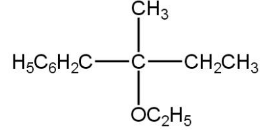
The major product of the following reaction is:

(A)
(B)
(C)

(D)

Answer
221.1k+ views
Hint: Given compound name is \[\left( 2-bromo-2-methyl\text{ }butyl \right)\] benzene and sodium ethoxide (\[{{C}_{2}}{{H}_{5}}ONa\]) which acts as a strong nucleophile reagent and also a strong base and thus, it tend to donate electron or seek cation. The reaction between both the compounds is followed by a substitution reaction (one nucleophile will substitute for another nucleophile).
Complete Step by Step Solution:
In a given compound \[\left( 2-bromo-2-methyl\text{ }butyl \right)\], bromine’s electronegativity is quite high as compared to carbon to which it is bonded. Due to its high electronegativity, it tends to attract a bond pair of electrons towards itself and become negatively charged. This results in creation of three-degree carbonation such as

The resultant compound is unstable because it is a charge compound and not neutral compound and it tends to get neutral by the attack of another nucleophile. Sodium ethoxide (\[{{C}_{2}}{{H}_{5}}ONa\]) and ethanol (\[{{C}_{2}}{{H}_{5}}OH\]) are strong nucleophilic reagents (electron-rich), attack on it and side product will be\[NaBr\](attacked by sodium ethoxide) or\[HBr\] (attack by ethanol) such as

The major product is obtained by nucleophile substitution in this reaction and products obtained by elimination reaction are minor.
Thus, the correct option is A.
Note: Bromine (leaving group) is a good nucleophile due to which substitution reaction is preferred. If in the place of bromine, a strong and bulky base is present then an elimination reaction takes place and the major product will be obtained by elimination reaction and not by a substitution reaction. Also, neutral species are more stable than charged species.
Complete Step by Step Solution:
In a given compound \[\left( 2-bromo-2-methyl\text{ }butyl \right)\], bromine’s electronegativity is quite high as compared to carbon to which it is bonded. Due to its high electronegativity, it tends to attract a bond pair of electrons towards itself and become negatively charged. This results in creation of three-degree carbonation such as

The resultant compound is unstable because it is a charge compound and not neutral compound and it tends to get neutral by the attack of another nucleophile. Sodium ethoxide (\[{{C}_{2}}{{H}_{5}}ONa\]) and ethanol (\[{{C}_{2}}{{H}_{5}}OH\]) are strong nucleophilic reagents (electron-rich), attack on it and side product will be\[NaBr\](attacked by sodium ethoxide) or\[HBr\] (attack by ethanol) such as

The major product is obtained by nucleophile substitution in this reaction and products obtained by elimination reaction are minor.
Thus, the correct option is A.
Note: Bromine (leaving group) is a good nucleophile due to which substitution reaction is preferred. If in the place of bromine, a strong and bulky base is present then an elimination reaction takes place and the major product will be obtained by elimination reaction and not by a substitution reaction. Also, neutral species are more stable than charged species.
Recently Updated Pages
Difference Between Alcohol and Phenol: Structure, Tests & Uses

Classification of Drugs in Chemistry: Types, Examples & Exam Guide

Class 12 Chemistry Mock Test Series for JEE Main – Free Online Practice

Is PPh3 a strong ligand class 12 chemistry JEE_Main

Full name of DDT is A 111trichloro22bispchlorophenyl class 12 chemistry JEE_Main

Sodium acetate on heating with soda lime produce A class 12 chemistry JEE_Main

Trending doubts
JEE Main 2026: Application Form Open, Exam Dates, Syllabus, Eligibility & Question Papers

Derivation of Equation of Trajectory Explained for Students

Hybridisation in Chemistry – Concept, Types & Applications

Understanding the Angle of Deviation in a Prism

How to Convert a Galvanometer into an Ammeter or Voltmeter

Degree of Dissociation: Meaning, Formula, Calculation & Uses

Other Pages
Solutions Class 12 Chemistry Chapter 1 CBSE Notes - 2025-26

NCERT Solutions For Class 12 Chemistry Chapter 1 Solutions - 2025-26

The D and F Block Elements Class 12 Chemistry Chapter 4 CBSE Notes - 2025-26

NCERT Solutions for Class 12 Chemistry Chapter Chapter 7 Alcohol Phenol and Ether

NCERT Solutions ForClass 12 Chemistry Chapter Chapter 8 Aldehydes Ketones And Carboxylic Acids

JEE Advanced Marks vs Ranks 2025: Understanding Category-wise Qualifying Marks and Previous Year Cut-offs




